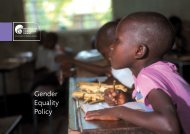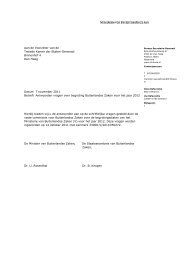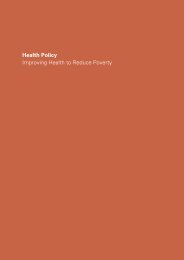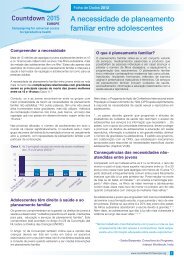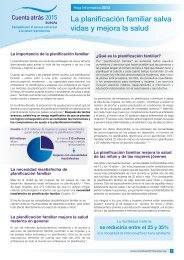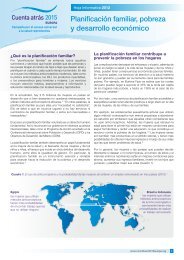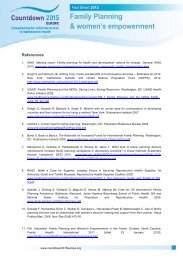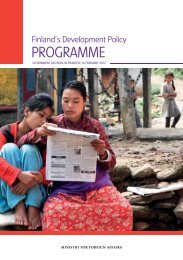The Unmet Need for Family Planning - Countdown 2015 Europe
The Unmet Need for Family Planning - Countdown 2015 Europe
The Unmet Need for Family Planning - Countdown 2015 Europe
You also want an ePaper? Increase the reach of your titles
YUMPU automatically turns print PDFs into web optimized ePapers that Google loves.
ReferencesAsh<strong>for</strong>d, L. (2003) <strong>Unmet</strong> need <strong>for</strong> family planning. Policy Brief. Washington, DC:Population Reference Bureau.Barot, S. (2008) Back to Basics: <strong>The</strong> Rationale <strong>for</strong> Increased Funds <strong>for</strong> International<strong>Family</strong> <strong>Planning</strong>. Policy Review. Washington, DC; Guttmacher Institute.Birdsall, N., A. Ibrahim, et al. (2004) Task Force 3 Interim Report on Gender Equality.Millennium Project background paper. New York: United Nations.Bloom D, Williamson J. Demographic Transitions and Economic Miracles in EmergingAsia. World Bank Economic Review. 1998.12:419–55. http://www.nber.org/papers/w6268.pdf?new_window=1.Bryant, L., L. Carver, et al. (2009) Climate change and family planning: least-developedcountries define the agenda. Bulletin of the World Health Organization 87: 852–857.Center <strong>for</strong> Global Development Case 13: Reducing Fertility in Bangladesh. Case Study.Washington, DC: Center <strong>for</strong> Global Development.Center <strong>for</strong> Reproductive-Rights/UNFPA (2010) <strong>The</strong> Right to Contraceptive In<strong>for</strong>mationand Services <strong>for</strong> Women and Adolescents. Briefing Paper. New York: Center <strong>for</strong>Reproductive Rights and UNFPA.<strong>Europe</strong>an Commission (2007) Reproductive Health Commodity Security Study: Keyfindings and recommendations <strong>for</strong> the <strong>Europe</strong>an Commission. Final report. Brussels:<strong>Europe</strong>an Commission.FHI. Women’s Voices, Women’s Lives: <strong>The</strong> Impact Of <strong>Family</strong> <strong>Planning</strong> – A Synthesisof Findings from the Women’s Studies Project. North Carolina, USA: <strong>Family</strong> HealthInternational.Grown, C., G. Gupta, et al. (2003) Background Paper of the Task Force on Educationand Gender Equality, Promises to Keep: Achieving Gender Equality and theEmpowerment of Women. Millennium background paper. New York: United Nations:5 and 11.Guttmacher (2010) Facts on Investing in <strong>Family</strong> <strong>Planning</strong> and Maternal and NewbornHealth. In Brief. Washington, DC: Guttmacher Institute.Guttmacher/Ethiopian Society of Obstetricians and Gynecologists (2010) Benefits ofMeeting the Contraceptive <strong>Need</strong>s of Ethiopian Women. In Brief. Washington, DC:Guttmacher Institute/UNFPA.Guttmacher/IPPF (2010) Facts on Satisfying the <strong>Need</strong> <strong>for</strong> Contraception In DevelopingCountries. In Brief. Washington, DC: Guttmacher Institute and IPPF.IPPF (2006) Death and Denial: Unsafe Abortion and Poverty. London: IPPF.IPPF (2008) Contraception at a crossroads. London: IPPF.Lancet/UCL (2009) Managing the health effects of climate change. Lancet 373: 1693–1733.Lule, E., S. Singh, et al. (2007) Fertility Regulation Behaviors and <strong>The</strong>ir Costs:Contraception and Unintended Pregnancies in Africa and Eastern <strong>Europe</strong> & CentralAsia. Health, Nutrition and Population (HNP) Discussion Paper. Washington, DC:World Bank Human Development Program.Mackenzie, H., A. Drahota, et al. (2010) What kind of family planning deliverymechanisms increase family planning acceptance in developing countries? A mixedmethods Systematic Review. Hampshire: DFID.OECD Development Centre. (2007) Gender Equality And Social Institutions In KyrgyzRepublic. Social Institutions & Gender Index (SIGI). Retrieved 20 October 2011 fromhttp://genderindex.org/sites/default/files/pdfs/KGZ.pdf.PPAG (2009) <strong>The</strong> Case <strong>for</strong> Adding <strong>Family</strong> <strong>Planning</strong> on the National Health InsuranceScheme (NHIS). Position Paper. Accra: Planned Parenthood Association of Ghana.RHSC. Fact Sheet: HAND to HAND Campaign Core Messaging. Brussels:Reproductive Health Supplies Coalition.RHSC. Understanding 100 million. Brussels: Reproductive Health Supplies Coalition.Retrieved 18 October 2011 from http://www.rhsupplies.org/understanding-100-million.html.RHSC (2009) Make a Case <strong>for</strong> Supplies, Leading Voices in Securing ReproductiveHealth Supplies: An Advocacy Guide and Toolkit. Brussels: Reproductive HealthSupplies Coalition.Ross, J. and J. Stover (2009) Contraceptive Projections and the Donor Gap, Meetingthe Challenge. Brussels: Reproductive Health Supplies Coalition.Rutstein S.O. (2008) Further evidence of the effects of preceding births intervals onneonatal, infant and under-five years mortality and nutritional status in developingcountries: evidence from the demographic and health surveys. DHS Working Paper.Calverton, MD, USA: MacroInternational. 41.Sedgh, G., R. Hussain, et al. (2007) Women with an unmet need <strong>for</strong> contraception indeveloping countries and their reasons <strong>for</strong> not using a method. Occasional Report.New York: Guttmacher Institute. 37.Singh, S., J. Darroch, et al. (2009) Adding it up: <strong>The</strong> costs and benefits of investingin family planning and maternal and newborn health. New York: Guttmacher Instituteand United Nations Population Fund (UNFPA).Singh S. , J. Darroch, et al. (2012) Adding It Up: Costs and Benefits of ContraceptiveServices – Estimates <strong>for</strong> 2012. New York: Guttmacher Institute and United NationsPopulation Fund (UNFPA).Singh, S., D. Wulf, et al. (2009) Abortion worldwide: a decade of uneven progress.New York: Guttmacher Institute.Speidel, J., S. Sinding, et al. (2009) Making the Case <strong>for</strong> US International <strong>Family</strong><strong>Planning</strong> Assistance. Baltimore, MD: Johns Hopkins Bloomberg School of PublicHealth, Bill and Melinda Gates Institute <strong>for</strong> Population and Reproductive Health.UK APPG on Population, Development and Reproductive Health (2009) Better OffDead? A report on maternal morbidity from the UK All Party Parliamentary Groupon Population, Development and Reproductive Health. London: UK All PartyParliamentary Group on Population, Development and Reproductive Health.UN-DESA (2011) <strong>The</strong> Millennium Development Goals Report 2010. New York:United Nations.UN Secretary General (2010) Global Strategy <strong>for</strong> Women’s and Children’s Health.Geneva: United Nations.UN Women. <strong>The</strong> health sector is a key entry point <strong>for</strong> survivors. Virtual KnowldegeCentre to End Violence Against Women and Girls. http://www.endvawnow.org/en/articles/428-the-health-sector-is-a-key-entry-point-<strong>for</strong>-survivors.html.UN (2009) World population prospects: the 2008 revision, Highlights. Working Paper.New York: United Nations.UN (2011) <strong>The</strong> Millennium Development Goals Report 2011. New York: UnitedNations.UN (2011) World Contraceptive Use 2010. New York: United Nations.UNDP (2010) Gender, Climate Change and Community-Based Adaptation. NewYork: UNDP.UNFPA (2002) State of the World Population 2002. New York: UNFPA.UNFPA (2005) State of the World Population 2005. New York: UNFPA.USAID. <strong>Family</strong> planning enlists imams in Egypt. Success Story. Washington, DC: USAID.USAID Indonesia. Birth spacing empowers Indonesians. Success Story. Washington,DC: USAID.USAID (2009) Achieving the MDGs: <strong>The</strong> contribution of family planning, Yemen. HealthPolicy Initiative, Task Order 1. Washington, DC: USAID.USAID (2009) <strong>Family</strong> <strong>Planning</strong> and the MDGs: Saving Lives, Saving Resources. TaskOrder. Washington, DC: USAID Health Policy Initiative.USAID/DELIVER (2006) Guaranteeing Widespread Access to a Broad Choice ofContraceptives – Paraguay. State of the Practice Brief. Arlington, VA: USAID andDELIVER.USAID/WHO Regional Office <strong>for</strong> Africa (2008) Repositioning family planning: Guidelines<strong>for</strong> advocacy action. Washington, DC: World Health Organization, Regional Office <strong>for</strong>Africa, and the United States Agency <strong>for</strong> International Development (USAID). http://www.who.int/reproductivehealth/publications/family_planning/fp_advocacytool_kit.pdf.Vlassoff, M., A. Sundaram, et al. (2009) Benefits of meeting the contraceptive needs ofUgandan women. In Brief. New York: Guttmacher Institute: 4.WHO (2009) Achieving Millennium Development Goal 5. Briefing Note. Geneva: WHO.WHO (2009) Strategic Considerations <strong>for</strong> Strengthening the Linkages between<strong>Family</strong> <strong>Planning</strong> and HIV/AIDS Policies, Programs and Services. Geneva: WHO.WHO (2010) Meeting report: <strong>Family</strong> planning <strong>for</strong> health and development: actions<strong>for</strong> change. Geneva: WHO.WHO (2010) Trends in Maternal Mortality 1990–2008. Geneva: WHO.WHO (2011) Unsafe Abortion: Global and regional estimates of the incidence ofunsafe abortion and associated mortality in 2008, 6th Edition. Geneva: WHO.www.countdown<strong>2015</strong>europe.org39



